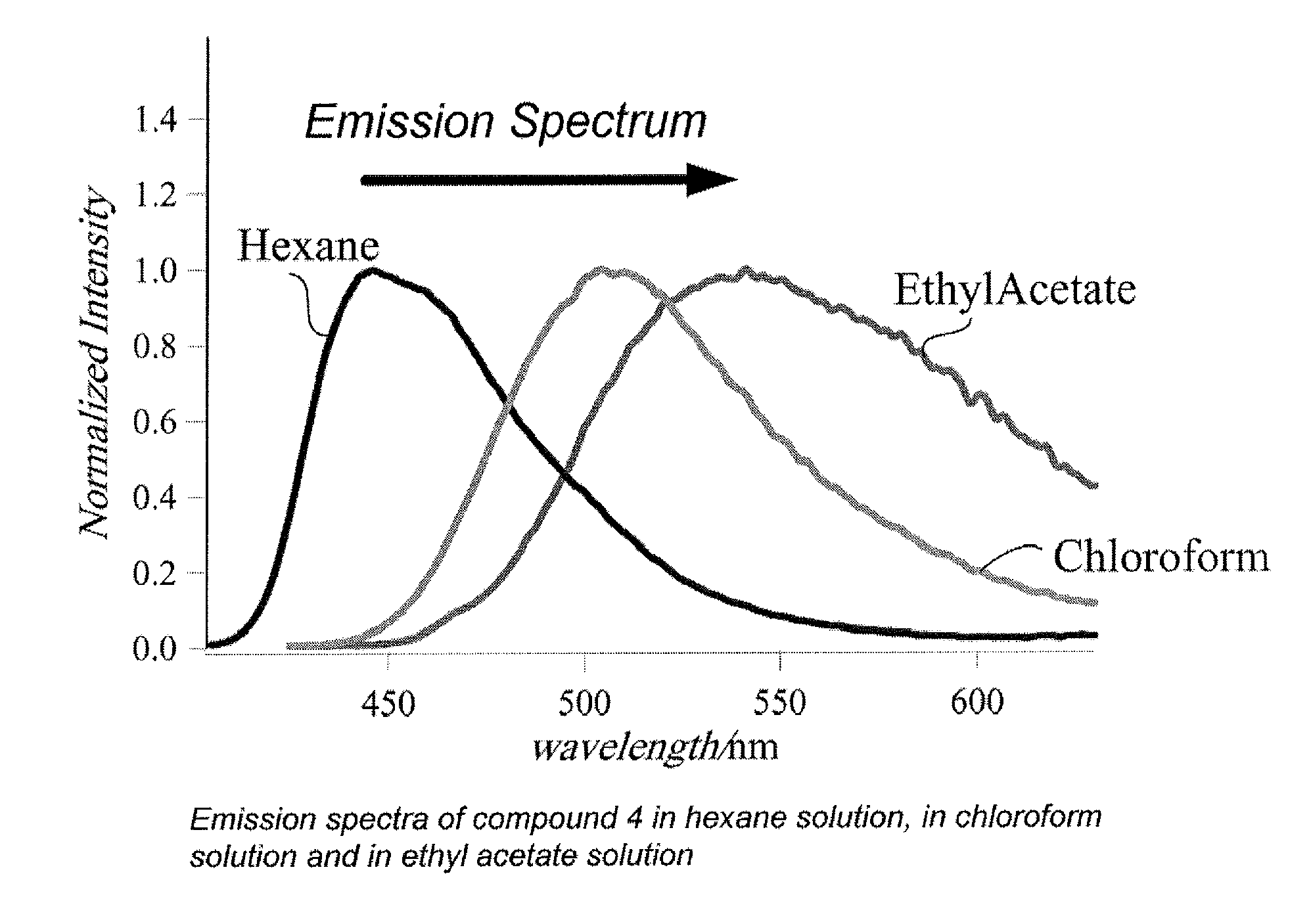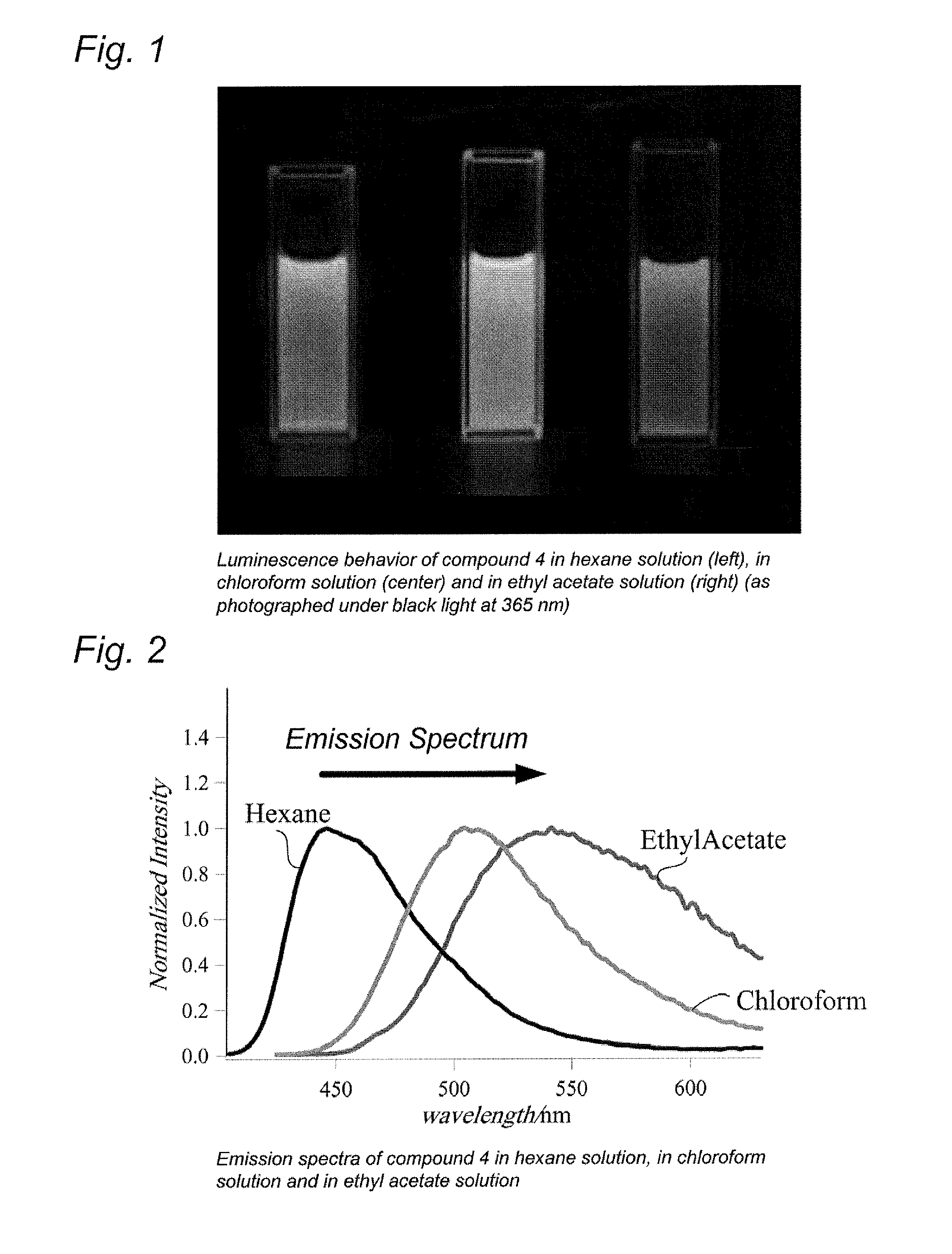Quinoline compound
a technology of quinoline compound and quinoline, which is applied in the direction of organic chemistry, etc., can solve the problems of limited means of changing the luminescent color and the limited design of the device with the solid luminescent compound, and achieve the effect of excellent solvatochromism
- Summary
- Abstract
- Description
- Claims
- Application Information
AI Technical Summary
Benefits of technology
Problems solved by technology
Method used
Image
Examples
example 1
Compound 1: 2,4-trifluoromethyl-7-aminoquinoline, TFMAQ
[0031]According to the above-mentioned production scheme 1, 2,4-trifluoromethyl-7-aminoquinoline (TFMAQ) was produced.
[0032]1.0 g (9.26 mmol) of m-phenylenediamine and 1.5 g of montmorillonite were put into 30 ml of toluene, and dissolved therein under heat. 1.6 ml (1.1 eq) of haxafluoroacetylacetone was added thereto and heated at 90° C., and after 1 hour, the heating was stopped, and after hot suction filtration (washing with ethyl acetate), the solvent was evaporated away under reduced pressure to around a half. A yellow solid precipitated by cooling was suction-filtered and washed with hexane to be 2.5 g (96%) of a yellow solid.
[0033]Subsequently this was recrystallized to be a yellow crystal of the compound 1.
[0034]1H-NMR (270 MHz, CDCl3)
[0035]δ=8.00 (d, 1H, J=8.72 Hz)
[0036]7.71 (s, 1H)
[0037]7.37 (d, 1H, J=2.03 Hz)
[0038]7.21 (d, 1H, J=9.40 Hz)
[0039]4.34 (s, 2H)
[0040]FAB-MASS
[0041]281 (M+1)
[0042]IR (KBr)
[0043]3461, 3333 cm−1...
example 2
Compound 2: 2,4-trifluoromethyl-7-N,N-dimethylaminoquinoline
[0047]According to the above-mentioned production scheme 2, 2,4-trifluoromethyl-7-N,N-dimethylaminoquinoline was produced.
[0048]280 mg (1.0 mmol) of TFMAQ was dissolved in 7 ml of acetonitrile. 0.5 ml (8 eq) of methyl iodide was added to the solution, and heated at 90° C. After thus heated for 14 hours, 0.5 ml (8 eq) of methyl iodide was further added thereto, heated for 2 hours, then the reaction was stopped, the solvent was evaporated away under reduced pressure, and the residue was purified through silica gel column chromatography (eluted with hexane:ethyl acetate=10:1) to give 50 mg (yield, 16%) of the compound 2 as an orange solid.
[0049]1H-NMR (270 MHz, CDCl3)
[0050]δ=8.02 (dd, 1H, J=7.4 Hz)
[0051]7.64 (s, 1H)
[0052]7.38 (dd, 1H, J=6.8 Hz)
[0053]7.29 (d, 1H, J=3.5 Hz)
[0054]3.17 (s, 6H)
example 3
Compound 3: 2,3-pentafluoroethyl-7-aminoquinoline
[0055]According to the above-mentioned production scheme 3, 2,3-pentafluoroethyl-7-aminoquinoline was produced.
[0056]200 mg (1.85 mmol) of m-phenylenediamine and 0.56 g of montmorillonite were dissolved in 16 ml of chloroform. 0.6 ml (1.1 eq) of decafluoroheptane-3,5-dione was added thereto and heated at 70° C. After this was heated for 17 hours in total, 0.6 ml (1.1 eq) of decafluoroheptane-3,5-dione was further added thereto. After 8 hours, the heating was stopped, and after suction filtration, the solvent was evaporated away under reduced pressure, and the residue was purified through silica gel column chromatography (eluted with chloroform) to give 557 mg (79%) of the compound 3 as a yellow solid.
[0057]1H-NMR (270 MHz, CDCl3)
[0058]δ=8.05 (d, 1H, J=10.1 Hz) 7.67 (s, 1H)
[0059]7.38 (d, 1H, J=2.70 Hz)
[0060]7.19 (d, 1H, J=9.45 Hz)
[0061]4.33 (s, 2H)
[0062]FAB-MASS
[0063]380 (M+)
PUM
 Login to View More
Login to View More Abstract
Description
Claims
Application Information
 Login to View More
Login to View More - R&D
- Intellectual Property
- Life Sciences
- Materials
- Tech Scout
- Unparalleled Data Quality
- Higher Quality Content
- 60% Fewer Hallucinations
Browse by: Latest US Patents, China's latest patents, Technical Efficacy Thesaurus, Application Domain, Technology Topic, Popular Technical Reports.
© 2025 PatSnap. All rights reserved.Legal|Privacy policy|Modern Slavery Act Transparency Statement|Sitemap|About US| Contact US: help@patsnap.com



